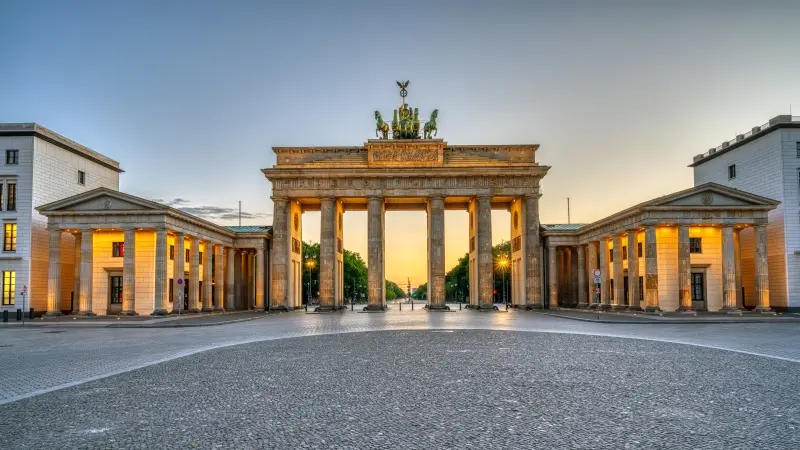Explore the must-visit historical places in Berlin, showcasing the city’s rich past and its pivotal role in European and world history.
Berlin, the capital of Germany, is a city brimming with history and culture, reflecting a complex past of political upheaval, war, and reunification.
Today, it stands as a vibrant, modern metropolis, yet its rich historical sites remain deeply woven into the fabric of the city.
Also Read
From remnants of the Berlin Wall to opulent palaces and museums, Berlin offers a wide variety of landmarks that bring its tumultuous history to life.
Here are 10 must-visit historical places in Berlin, each of which offers a unique insight into the city’s past.
1. Brandenburg Gate
One of the most iconic symbols of Berlin, the Brandenburg Gate has stood for over two centuries, witnessing some of the most significant events in German history.
Completed in 1791, it originally symbolized peace and was a neoclassical triumphal arch.
However, after World War II, the gate became a powerful symbol of division during the Cold War when the Berlin Wall ran directly through it.
Following the fall of the Wall in 1989, the Brandenburg Gate came to represent German reunification and a new era of peace and unity.
The Brandenburg Gate is a must-see for its historical significance and stunning architecture. It also serves as a gathering place for national celebrations and important political events.
2. Berlin Wall Memorial (Gedenkstätte Berliner Mauer)
The Berlin Wall Memorial on Bernauer Strasse is one of the most poignant sites related to the Cold War era.
The memorial stretches along the former border and includes a preserved section of the Wall, a watchtower, and an exhibition that explains the history of the Wall and the division of Berlin.
It also houses a Documentation Center with information about the people who tried to escape and the political context of the Wall.
Visiting the Berlin Wall Memorial allows you to experience the personal and political impact of the division of Germany and the Wall’s dramatic fall. It is a powerful reminder of the struggles for freedom during the Cold War.
3. Reichstag Building
The Reichstag Building is one of the most significant landmarks in Berlin. It has been at the center of German politics since its completion in 1894.
Although it was severely damaged in a fire in 1933 (an event that played a key role in Adolf Hitler’s rise to power), it was restored after reunification.
Today, the Reichstag serves as the home of the German Bundestag (parliament). Its striking glass dome, designed by architect Norman Foster, offers panoramic views of the city.
The Reichstag’s role in German history is monumental, and its dome is a symbol of the transparency and unity of the modern German state. Visitors can enjoy stunning views while learning about Germany’s political evolution.
4. Checkpoint Charlie
Checkpoint Charlie was one of the most famous crossing points between East and West Berlin during the Cold War.
Situated in the former Berlin Wall border zone, this checkpoint became a symbol of the tensions between East and West during the Cold War.
Today, a replica of the checkpoint booth is positioned at the site, along with a museum that details the escape attempts, spy activities, and events surrounding the Wall.
Checkpoint Charlie provides an eye-opening look at the division of Berlin and the dramatic stories of those who tried to cross the border. The museum offers personal accounts and exhibits that shed light on the human cost of the Cold War.
5. Pergamon Museum
Located on Berlin’s Museum Island, the Pergamon Museum is one of the world’s most famous archaeological museums.
Its collections include spectacular reconstructions of ancient structures, such as the Ishtar Gate of Babylon and the Pergamon Altar.
The museum provides a detailed insight into the civilizations of the ancient Mediterranean and Near East, making it a must-visit for history enthusiasts.
The Pergamon Museum offers an opportunity to step back in time and explore some of the most extraordinary archaeological finds in history. Its artifacts and reconstructions provide a fascinating glimpse into ancient cultures.
6. Charlottenburg Palace
Charlottenburg Palace, the largest palace in Berlin, was built in the late 17th century and expanded over the years to become a symbol of royal opulence.
The palace is set within beautiful gardens and houses extensive collections of art, porcelain, and artifacts from the royal family’s time.
The palace is a stunning example of baroque architecture and gives visitors insight into the grandeur of pre-modern Germany.
For those interested in royal history and architecture, Charlottenburg Palace is a stunning example of Germany’s imperial past. Its lush gardens and elegant interiors provide a look into the lives of the Prussian kings.
7. Holocaust Memorial (Memorial to the Murdered Jews of Europe)
The Holocaust Memorial is a stark and moving tribute to the six million Jews who died in the Holocaust.
Located near the Brandenburg Gate, the memorial consists of 2,711 concrete slabs of varying heights that create a disorienting maze.
Beneath the surface is the Underground Information Center, which provides historical context and personal testimonies about the Holocaust.
The Holocaust Memorial is a somber and powerful site that forces visitors to reflect on one of the darkest chapters in human history. It’s a place of remembrance, education, and respect for the victims of Nazi atrocities.
8. Berlin Cathedral (Berliner Dom)
The Berlin Cathedral, located on Museum Island, is a magnificent example of baroque architecture and a significant historical site.
The cathedral’s origins date back to the 15th century, but its current form was completed in 1905.
Visitors can explore the impressive interiors, climb to the dome for panoramic views of the city, and visit the crypt, which houses the tombs of former Prussian kings.
The Berlin Cathedral is both a religious site and a historical monument. Its impressive architecture and central location make it an essential stop for anyone exploring Berlin’s history and culture.
9. Bebelplatz and the Memorial to the Book Burning
Bebelplatz, located near the Humboldt University, is famous for its connection to the Nazi-era book burnings.
In 1933, Nazi officials burned thousands of books by Jewish, communist, and other “un-German” authors in the square.
Today, a memorial to this event sits beneath a glass plate on the square, where you can look down into empty bookshelves that serve as a poignant reminder of censorship and intellectual repression.
The Bebelplatz memorial is a place for reflection on the dangers of censorship and the importance of intellectual freedom. The haunting memorial allows visitors to connect deeply with the events of 1933.
10. Berlin’s Jewish Museum
The Berlin Jewish Museum is one of the largest and most important Jewish museums in Europe.
The museum’s architecture, designed by Daniel Libeskind, is as much a part of the experience as its exhibits.
The museum traces the history of Jews in Germany, from the Middle Ages to the present, with poignant exhibits on Jewish life, culture, and the impact of the Holocaust.
The Jewish Museum offers a profound and emotional journey through German-Jewish history.
Its innovative architecture and thought-provoking exhibits make it a must-visit for those interested in understanding the complexities of history and identity.
Berlin is a city that tells its history through its landmarks, museums, and memorials, each offering a unique perspective on the city’s past.
From the grandeur of Charlottenburg Palace to the somber remembrance of the Holocaust Memorial, these 10 historical places in Berlin provide an in-depth understanding of the city’s evolution.
Whether you’re interested in royal history, World War II, or the Cold War, Berlin’s historical sites offer something for everyone, making it an essential destination for history lovers.














